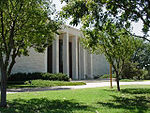Visit Presidential
Libraries
Presidential Libraries can be found across the country,
from Massachusetts to California
·
museums featuring interactive exhibits
·
interesting and fun public programs
·
important educational events
·
vast archives available for scholarly
research
Presidential Libraries Locations
Herbert Hoover Library - http://www.hoover.archives.gov/
Franklin D. Roosevelt Library - http://www.fdrlibrary.marist.edu/
Harry S. Truman Library - http://www.trumanlibrary.org/
Dwight D. Eisenhower Library - http://www.eisenhower.archives.gov/
John F. Kennedy Library - http://www.jfklibrary.org/
Lyndon B. Johnson Library - http://www.lbjlibrary.org/
Richard Nixon Library - http://www.nixonlibrary.gov/index.php
Gerald R. Ford Library - http://www.fordlibrarymuseum.gov/
Jimmy Carter Library - http://www.jimmycarterlibrary.gov/
Ronald Reagan Library - http://www.reaganlibrary.gov/
George H. W. Bush Library - http://bushlibrary.tamu.edu/
William J. Clinton Library - http://www.clintonlibrary.gov/
George W. Bush Library - http://www.georgewbushlibrary.smu.edu/
Picture not available for G.W. Bush
Recent
The presidential library system is made up of thirteen presidential libraries operated by the
The Richard Nixon Library and Birthplace was not originally part of the presidential library system. While the Nixon Presidential Materials Staff, which administers the Nixon presidential materials under the terms of the Presidential Recordings and Materials Preservation Act, is part of
The Presidential library system formally began in 1939, when President Franklin Delano Roosevelt donated his personal and Presidential papers to the federal government. At the same time, Roosevelt pledged part of his estate at Hyde Park, New York to the
In 1950, Harry S. Truman decided that he, too, would build a library to house his Presidential papers and helped to galvanize congressional action.
The thirteen Presidential Libraries maintain over 400 million pages of textual materials; nearly ten million photographs; over 15 million feet (5,000 km) of motion picture film; nearly 100,000 hours of disc, audiotape, and videotape recordings; and approximately half a million museum objects. These varied holdings make each library a valuable source of information and a center for research on the Presidency.
The most important textual materials in each library are those created by the President and his staff in the course of performing the official duties. Libraries also house numerous objects including family heirlooms, items collected by the President and his family, campaign memorabilia, awards, and the many gifts given to the President by American citizens and foreign dignitaries. These gifts range in type from homemade items to valuable works of art. Curators in Presidential libraries and in other museums throughout the country draw upon these collections for historical exhibits.
Other significant holdings include the personal papers and historical materials donated by individuals associated with the President. These individuals may include Cabinet officials, envoys to foreign governments, political party associates, and the President's family and personal friends. Several libraries have undertaken oral history programs that have produced tape-recorded memoirs. A third body of materials comprises the papers accumulated by the President prior to, and following, his Presidency. Such collections include documents relating to
With the exception of John F. Kennedy, Lyndon B. Johnson, Gerald Ford, and upon their own deaths, Jimmy Carter and George W. Bush, every American president since Hoover is or has chosen to be buried at his presidential library. Kennedy is buried at Arlington National Cemetery; Johnson is buried at his ranch in the hill country of Texas, west of Austin; Carter plans to be buried near his home in Plains, Georgia.[5] George W. Bush has a burial plot in the Texas State Cemetery [6]
Unlike all other Presidents whose libraries are part of the NARA system, Ford's library and museum are geographically separate buildings, located in different parts of Michigan; Ford is buried at his museum in Grand Rapids instead of his library in Ann Arbor.
We hope you'll consider going to some of the libraries, as we have enjoyed the few we've been too so immensely.












No comments:
Post a Comment